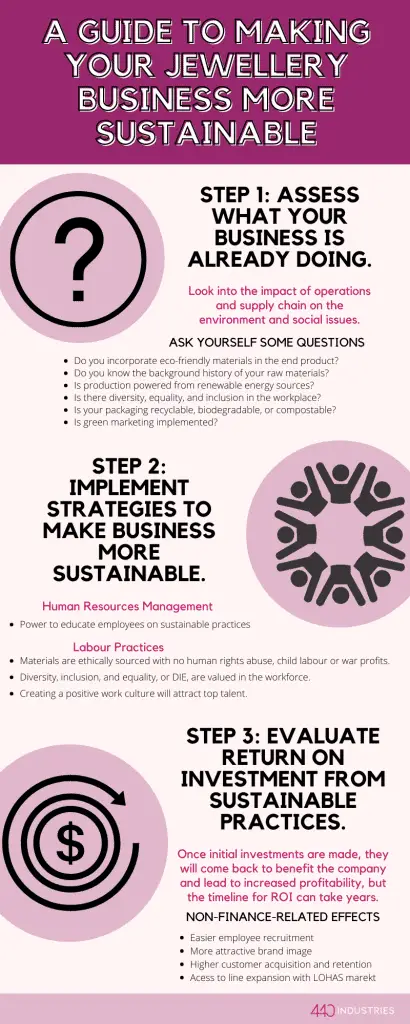Introduction
The jewellery industry can be a dirty place, especially when it comes to mining and even production and distribution. There is a way to combine jewellery making with nature. With many businesses in the jewellery industry, there are only a select few that follow sustainable practices. Sustainability in your business means managing the triple bottom line – profit, people, planet. We are going to discuss how you can transform your existing business practices into sustainable practices and how to review return on investment. Continue to see the checklist on reviewing your existing jewellery business actions.
- Assess what your business is already doing.
- Strategies to make business more sustainable.
- Return on investment from implementing sustainable practices.
- Conclusions

1. Assess what your business is already doing.
The first step to sustainability is assessment. Before you can even implement sustainable practices, you must know the current position of your jewellery business. Look into the impact of operations and supply chain on the environment and social issues. Here is a checklist of yes or no questions to use when reviewing your current business practices for areas of improvement and embedding sustainable practices.
Jewellery Design
- Do you incorporate eco-friendly materials in the end product?
- Are pieces made with reclaimed metals or other recycled materials?
Raw Materials
- Do you know the background history of your raw materials?
- Do you use gemstones that are free of harsh labor practices?
- If you use natural diamonds, do they follow the Kimberley Act?
- Are materials packaged efficiently to minimize packaging when shipped to you?
- Is packaging recyclable and made with eco-friendly materials?
- Is the surrounding area polluted during the extraction process?
- Is leather dyed to enhance colors?
Jewellery Production
- Are the work conditions respectable?
- Is production sourced from renewable energy sources?
- Are lights using energy efficient light bulbs?
- Is waste disposed of properly?
- Are metal materials reused?
- Are machinery and lights turned off when not in use?
- Is the thermostat turned down when the building is not in use?
- Is there diversity, equality, and inclusion in the workplace?
Distribution
- Is your packaging recyclable, biodegradable, or compostable?
- Is packaging made with recycled materials?
- Are your channels of distribution using clean energy to fuel processes?
- Do the distribution companies you work with create excessive amounts of waste?
- Are workers paid fair wages?
Sales and Marketing
- Is green marketing implemented?
- Do you highlight your sustainability efforts related to ethically sourcing, superb work conditions, eco-friendly products, etc.?
- Are print ads made with recycled paper while utilizing both sides?
- Do you encourage customers to become involved with sustainability?
If you answered ‘yes’ to a majority of the questions, your business is headed in the right direction. A large number of ‘no’ answers signifies you should consider implementing sustainable strategies to greenify your business. Besides basing your practices solely around your own businesses’ problems, evaluate global issues too. We will discuss approaches to start implementing sustainability in the next section so continue reading to learn more.
2. Strategies to make business more sustainable.
Once you have reviewed your business, you will move into change management. What kind of strategies can be adopted to make your business more sustainable? Making your business sustainable is a long-term deal, and these can be simple fixes or complex technologies. There are no common set of rules or standards you must follow to source responsibility, so it is completely in your own hands.
Look at where you are currently located in terms of sustainability and picture what the future of your company will look like in order to decide which strategies to implement to change existing operations. We are going to focus on human resources management and labour practices, in addition to what other top jewellery companies are doing.
- Human Resources Management. Employees are one of the strongest assets to a company. Human resources management relates to hiring, motivating, and maintaining these employees in the workforce. HR is a leading agent in adopting sustainability and can greatly impact it. They have the power to educate and train employees on sustainable practices when it comes to their own work within the company and when working with other companies as it relates to supply, production and distribution. This change will already be embedded in new employees because of onboarding. HR can provide objectives and encourage employees in energy-saving practices such as turning off lights, carpooling, and using public transportation. By supplying technology, HR can help save paper by moving necessary employee documents electronically. Reducing the need for paperwork can save space and provide additional organization. Incorporating employees into sustainability practices will not only bring more efficient business processes but it will leave employees more engaged.
- Labour Practices. Poor working conditions can lead to harsh employee treatment. Some groups, like workers with disabilities, women, and youth and older workers, are vulnerable to discrimination too. Gemstones have a special elegance to them that customers value but sometimes unethical labour comes behind them. Businesses need to verify labour standards within their own operations and supply chain. During the extraction process, miners often work in unsafe and poorly constructed mines that are vulnerable to collapse, resulting in injury or death. Most of the time, miners are working long hours in hot temperatures with little food and water. They are exposed to pollutants like chemicals and dust from the extraction process. Some equipment can be hazardous and produce loud sounds that can be uncomfortable and damaging. Any errors could greatly endanger the health of another miner, and the pay is little compared to the rigorous physical work and harsh working conditions. Ensure precious metals and other natural gemstones are ethically sourced and guarantee no human rights abuse, child labour or war profits. Although a majority of unethical labour practices occur during the mining process, they can still take place within production and distribution. Businesses should do their part when it comes to protecting human rights and becoming diverse. Diversity, inclusion, and equality, or DIE, should be valued in the workforce. When it comes to diversity, it doesn’t have to necessarily deal with skin. Other aspects including gender, age, ethnicity, religious beliefs, age, sexual orientation, and disabilities are a part of diversity. A company should implement DIE strategies and stick to them, so rights are made top priority. Having a diverse workplace will also bring new ideas and strengthen work ethic. In addition to DIE, your company should take interest in certain groups, like women’s empowerment and gender equality. Until recently, women have been underrepresented in top decision-making roles. Women continue to be targeted and do not receive equal pay for the same work, compared to their male counterparts. Because of this, it is essential to create a workplace where gender equality is present, and women can become leaders and be a part of company decisions. Creating a positive work culture will attract top talent because employees will want to be a part of a company that prioritizes ethics over profits. If any negative human rights issues arise, be sure to respond quickly to remove them. Focusing on the people within your company will help build an inclusive and productive business environment and create a stronger, sustainable future.
- Other leading jewellery businesses. As discussed in a previous blog article, two of the leading jewellery businesses in the world have sustainable business models – Tiffany and Co. and Pandora. However, these companies did not completely start off being sustainable. They are currently implementing strategies and are taking years to work towards coming completely eco-friendly. Some of their best approaches include setting high standards for diversity, inclusion, and equality in their workforce, ensuring every step of their products’ journey does not harm the planet or any people by sourcing responsibly, and taking actions to protect the natural world by using natural energy and recycling materials to eliminate their environmental footprint, which you can relate back to your jewellery business.
Your business can still create beautiful jewellery pieces while diminishing the environmental footprint. When turning to sustainable practices, source from mines that provide fair wages and safe working conditions for miners. Within company operations, human rights should be protected as well. We provided you with strategies that your business can adopt but may be wondering how this will benefit your business. We are going to discuss the return on investment in the next section.
3.Return on investment from implementing sustainable practices.
Once you have applied these sustainability practices, you will be able to see the sustainable return on investment (S-ROI). You are able to assess the efficiency of these operations relative to the cost. Some may wonder how long it takes before you can notice a difference. The answer is that it will take time before you see results and the time frame varies for different projects, but it can occur within months to years. You will start to notice small improvements, but the full investment from purchasing capital will usually not be recouped for many years down the road. If you invest in solar panels or other forms of renewable energy, you will have energy powering your facility for free, in a matter of years. With the startup cost high, your business can raise prices. Studies show that customers are willing to pay up to 15% more for a sustainable product.
What type of returns are there for sustainability initiatives, from a bottom line perspective? Here are types of returns that can be foreseen for companies investing in sustainable practices.
- Investments in socially ethical practices may initially cost a business money. Once initial investments are made, they will come back to benefit the company and lead to increased profitability. However, the timeline for ROI is extended and can take years. For instance, when using renewable sources of energy, the costs can add up quickly as you take into account the size of your facility, the wattage, and installation. Yes, the initial cost may be more than traditional energy forms, but there will be a lower energy bill that will eventually be paying for itself.
Besides having an increase in profitability, there will be additional affects you will notice.
- Employee Recruitment – Emphasizing sustainability in your business will attract more job candidates. Workers will want to be a part of a company that values human rights and are environmentally cautious. In fact, younger generations are more likely to support these issues so your business will have fresh perspectives and high enthusiasm.
- Branding – Corporate social responsibility can help companies develop a more attractive brand image. Customers, especially eco-friendly millennials, will be more likely to purchase from you.
- Customer Acquisition and Retention– Your business will be able to attract more environmentally-conscious customers. Despite higher prices, product demand and customer loyalty will go up because customers are wanting to shop with sustainable companies.
- Line Expansion – Your business will be able to make jewellery that appeals to the LOHAS market. LOHAS, lifestyle of health and sustainability, is a growing market consisting of consumers that want to do business with companies that share the same values as them – sustainability, socially responsible actions, women’s rights, energy efficiency and more. They have a specific buying behavior that takes into account personal, community, and planetary outcomes.
With jewellery that speaks to the LOHAS market, stronger company branding and profitability, your business will greatly benefit from sustainability. All in all, it is worth the investment for your jewellery business.
4. Conclusions
If you ask yourself a few questions about your existing jewellery business processes, you are sure to find opportunities for improvement. You won’t be able to see any improvements in your jewellery business unless you take the first step.
We have provided you with actions your business can follow, but your business can take inspiration from what some of the most sustainability-oriented jewellery companies are already doing. Become energy efficient or focus on human rights. By changing your sustainability practices, you can positively impact your ROI and will attract publicity from green-conscious consumers. Not only will your business see profitability, there will be strengthened company branding and higher customer retention rates. What you do today will have a positive effect on the future, so begin taking the first step.
If you’re looking for an opportunity to deepen your understanding and knowledge of the practices of sustainable fashion, don’t hesitate to take a look at our course “The Sustainable Fashion Industry“. Our short and to-the-point, online class covers a wide range of topics spanning from sustainable business models to strategies to lower your carbon footprint. Here’s a link to the course, if you use the discount code BLOG20 at checkout you can access a 20% discount. Enjoy!







